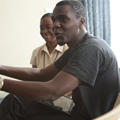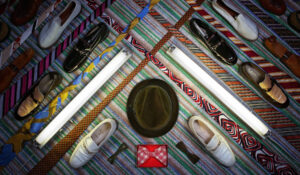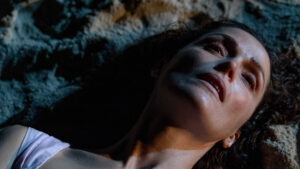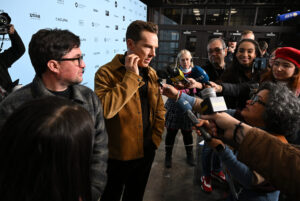Habiba (Tanzania) and Rogers (Kenya)
Phillip Himberg, Producing Artistic Director, Sundance Theatre Program
Liesl Tommy (Workshop leader): “I know you guys don’t kiss on stage in Ethiopia, is that right?”
Silence.
Workshop Participant: “That is right.”
Silence
Second Workshop Participant: “But we are willing to try!”
This exchange blows me away. It is true. Kissing on stage is not permitted, not because the society is prudish, but because: this is ‘the culture’. There is not a need to show physical affection in public. It’s not done. This is how it is been. Now Sundance has arrived. And a new page turns.
After thirty minutes, three groups of our participants present their three-minute ‘plays’ – and each is site specific. The first is on a roof. We see two male friends, in typical conversation – full of intimate gestures: repeated kissing on the cheeks, hugs, one blowing on the other’s eye to get out an eyelash. They talk about a woman arriving, a Kiswahili speaking woman. They speak bad Kiswahili. It’s funny.
Then Habiba arrives. She sees the two men and their easy affection. She rebukes one man. And then, she turns and sings as only the Tanzanians can: a plaintive Swahili melody. Suddenly the scene is heart breaking.
Another director takes us to the toilets. Yes, the men’s toilets in the National Theatre. We all stand behind the urinals. I’m nervous. Have women ever been in a men’s room? Will people come and bring police? One of the actors stands in front of the urinal. Another arrives. The man at the urinal turns toward the new man, belt unbuckled. Is this what I think it is? A pickup? (This is simply NOT DONE in this country, not even discussed.) I sense our tiny audience holding its breath. And then the man at the urinal reaches into his pocket, and takes out a passport, and hands it to the visitor. That’s the ‘intimate exchange’. The passport is kissed. Got it.
A day before I am at Addis Ababa University, a lush green campus, filled with flowers.
“And, Philip, may I ask, why exactly you choose our country in East Africa as a Sundance place?” The gentle man who poses this question, is one of 40 or so undergraduate students in the Department of Theatre Studies. Four of us have been invited to introduce the ideas of the Sundance Institute Theatre Program, the nature of play development and what we believe the connections are between our very disparate cultures. I am touched. This visit to Ethiopia as been one of intense inquiry – on both sides. And, I am impressed that this barely nineteen-year-old is thinking about the impetus for our appearance in his homeland. It forces me to think back – nearly a decade, to my first time in the region and how meaningful it was to meet artists responding powerfully to tectonic changes in their cultures – politically and socially. This is why we are here: we know now that there is a new generation of theatre makers, who feel compelled to comment on, challenge and lead their communities. And that is what I say. “Sundance believes in you, in your ability and in ultimately your responsibility to be the artist who stands in front; you are like the poet in a nomadic society who leads their tribe to the watering hole. Only he/she remembers where that water is.” Note: I stole that image from an Anne Bogart book (handy!).
The campus of Addis Ababa University services nearly 50,000 people. It is centered around the former Palace of Haile Selassie, who donated the land to the University. We tour the Emperor and Empress’ former home – bedroom, bathrooms, wardrobes, a stuffed lion, and also visit the History Museum containing a huge range of artifacts from the myriad tribes that make of this country – 80 languages are spoken here.
We meet with the Director of the Theatre Program and discuss how Sundance might connect them with U.S. opportunities: cultural envoys, Fulbright instructors, script donations, and guest artists.
Later in the afternoon we make our way into the fortress of the American Embassy for our meeting with the Public Affairs Office and Cultural Attaché. Years of these governmental meetings at identical buildings across East Africa has made us bold. We are less shy or seductive; we speak our minds – about the need for the U.S. to step up its “cultural diplomacy”, our core belief that the goals of U.S. diplomacy can, in part, be met by the coming together of Ethiopian and U.S. theatre artists – that we can “tell the stories”. The men are surprisingly receptive. They are restricted by small budgets but somehow understand our commitment – over a decade now – and our knowledge of the theatrical scene. We bring something. I believe our ‘asks’ will not go utterly unheeded in the future.
Later, in the evening, we all sit in a packed theatre to watch an Ethiopian comedy, performed in Amharic. As at every theatre we’ve seen in this city, people line up hours in advance and the place is overflowing. Over 1000 people. And you know what? They are YOUNG. The audience is easily under 30. What my colleagues who run producing theaters yearn for – a young enthusiastic audience. Theatre happens six nights a week. And it’s always like this. They come to theatre (it costs the equivalent of 80 cents) after work. This is their entertainment. They do not watch (or in many cases) even own a television or computer. They celebrate together sitting in a theatre with five lights, and a dusty curtain.
Honestly, it’s a tough go for us visitors. Ethiopian theatre is by and large not imagistic, visual – it’s all about language. The audience laughs and roars over and over again. For two hours. I think: “Neil Simon? Christopher Durang?” What is our equivalent? I’m not sure. Even not knowing the language I can both appreciate the connection to the audience and, I believe, find deficiencies in some of the director’s and actors’ choices. I anxiously await a de-brief with our Addis participants – so I can better understand. Two hours later, we come back to our hotel – filled to the brim with images of the day.
Next day. I am back in our workshop space at the National Theatre. Tesfaye says: “The point of composition is to make the intangible, tangible.” This is in reference to an exercise about staging, that the group attempted yesterday. Revelations about the myriad ways actors can physically relate on stage and to the audience. I think his pronouncement is kind of amazing. So many conversations open up. Minds open up. Hearts open up. We are crossing a bridge and meeting in the middle. This is Sundance Institute East Africa.







